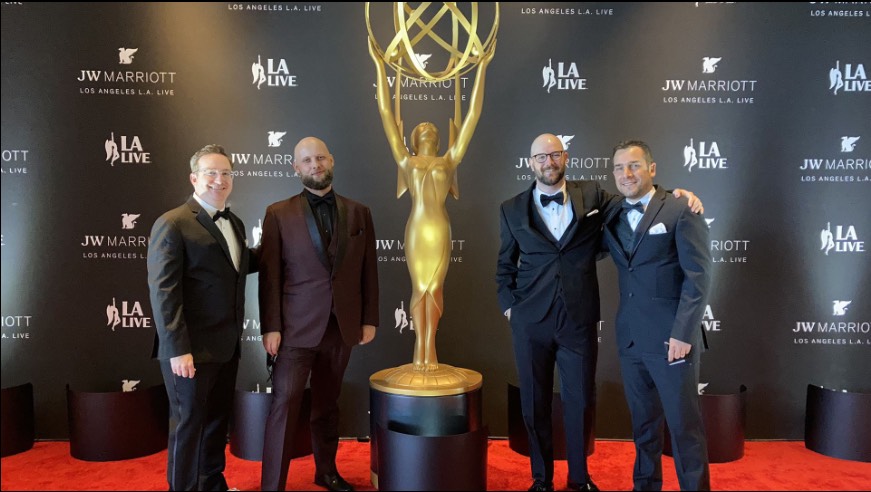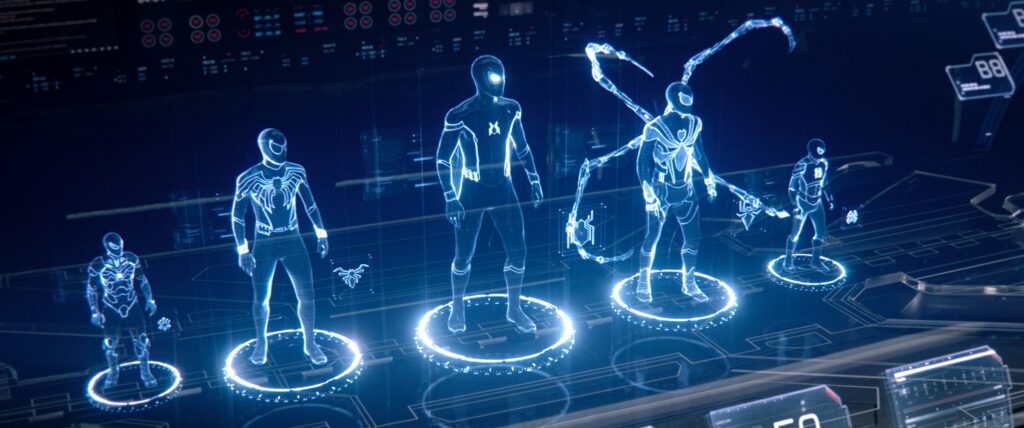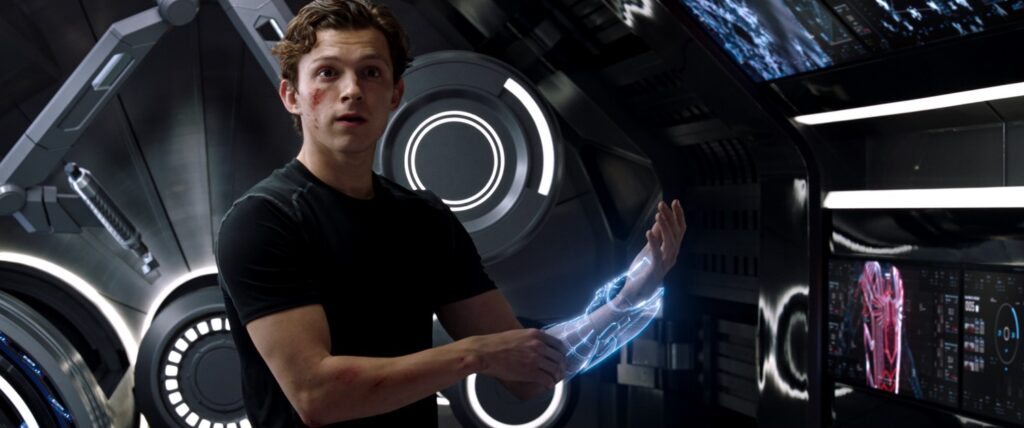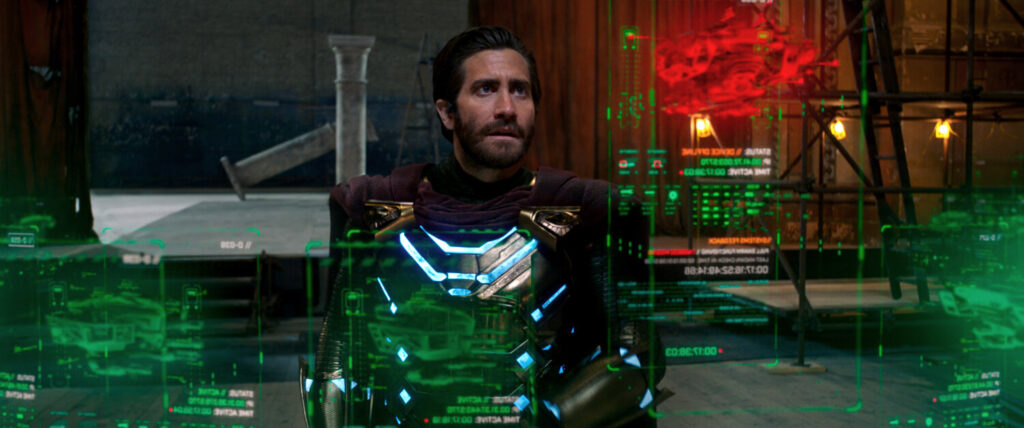If you’ve seen Black Panther, Spider-Man: Far from Home, WandaVision, The Falcon and the Winter Soldier, Black Widow and Shang-Chi and the Legend of the Ten Rings, then you’ve seen Nick Woythaler’s work.
The Baldwin born-and-raised visual effects (VFX) designer grew up utterly immersed in the world of the original Star Wars trilogy— and recalls watching Return of the Jedi behind-the-scenes footage that inspired him to pursue his own early filmmaking endeavors. In particular, Lucasfilm’s creative decision to implement “little action figures” to shoot forestset flying water bike sequences ahead of time on videotape inspired him to pursue the same recourse.
“They filmed the entire sequence and laid out every single shot in that fashion. From that point on, I started making little movies with my own Star Wars figures. That’s how I got into the whole medium,” Woythaler recalled in his hour-long interview with The Messenger on Saturday. Our conversation covered a wide range of topics pertaining to his career and impressions on the current state of the industry.
Early Roots
Woythaler, now 44, recalls building his own sets, getting into stop-motion animation, and manually adjusting figures after each “start and stop” take due to the limitations of the cameras of yesteryear at his disposal. He showed early promise, too, as he’d garner second place at the Queens Film Festival at just 12 years old.
During his fondly recalled adolescence, the time between Michael Keaton’s Batman takeover and the eerily believable “Death of Superman,” Woythaler notes his creative experimentations started to evolve into dreams-turned-logistically calculated executions of more live-action fare.
By 1999, then a 20-year-old film student at New York University, Woythaler had many routes he could have taken on the uncertain climb up the film chain. He’d meet his future wife, with whom he’d later have three children — an 11-year-old daughter, and 8-year-old twins, a boy and a girl – through a connection made on a Mexico-shot documentary he produced while semesterly abroad.
Despite this monumental life moment occurring thanks to on-set work, a few more instances of successive film set experience revealed to Woythaler quite clearly that on-set work was simply not for him. But he did recognize where his foremost forte and most of his creative passions lay: the video editing process— more specifically, editing within the visual graphic design arena.
Pursuing this line of work, however, did not mean instantaneously relinquishing the grind associated with creatively intense environments, though. Not by a long shot.
Moreover, eventually reaching a period where he’d take the long-delayed leap of faith and elect to market himself as a gun-for-hire freelancer seemed like a “very scary” career move at first. But, in doing so, he’s been provided consistent work and been respectably paid “since Day 1” across the past 13 years— including for a company Marvel Studios outsources to for their big-budget behemoths both of the large and small screen variety.
‘Small-Time Full-Time’ to ‘Big-Time Freelance’
As pictured in the demonstrative graphics Woythaler provided The Messenger, working for mega-movie blockbusters amidst obligatory confidentiality agreements means the VFX designer can be involved as early as pre-production, but most typically through the very end of post-production. Woythaler has been a leading force for effects teams responsible for key graphics – many of which are his personal creations (see: the graphic artwork stills from Spider-Man: Far from Home below)
Most notably, in 2021, he earned his first Emmy Award nomination for “Outstanding Main Title Design.” He and his team were recognized for that year’s Disney+ series, WandaVision. This was no small feat, as they certainly had their work cut out for them. The show memorably genre and era-jumped at will, and thus were constantly redefining its lead-in for audiences several times over.

“What I do can function at a few different levels: when design work happens before the film is shot, they’re planning out concept design,” Woythaler revealed. “Then, on the other end, you’re getting the shots coming in and you’re putting effects on top. You’re spending most of your time working on that design until it gets approved. And then one more thing would be the opening sequence designs, and those will mostly be towards the end, like WandaVision and The Falcon and The Winter Soldier.”

While discussing recent popular shows with personalities that still missed the boat in terms of adequately teeing up their audiences for what to expect, in many cases electing a bare minimum “default” approach to dropping their title card, Woythaler said he thinks about such elements “quite a lot.”
“When I watch a show, I ask, ‘What is the utility of the title sequence?’ I think, what they come to us for, they’re trying to set the tone for the show early on. What they’re trying to do is, there’s this premium aspect to the title sequence. They’re trying to bring you into this world, set the tone, set the ambiance and tell the audience what to expect. There are a lot of details to this show that you should really drink in. We’re really paying attention and taking good care of how to set up the experience of this show for them.”
“I don’t think every show needs it,” Woythaler clarified. “I’m not one of these people that says you need to watch it every episode. Oftentimes, it doesn’t change every episode, if you’ve seen it once or twice, that can be enough… (HBO’s soon-to-end action dramedy) Barry is just a huge ‘BARRY’ – that works. Stranger Things is its cool text that comes on… that works too. It all depends.”
Speaking of HBO, Woythaler currently plugs promos for the new True Detective season starring Jodie Foster, and for the Game of Thrones prequel series House of the Dragon. He noted the latter is one of the few shows that has all of its season scripts already locked and therefore are still shooting unfazed despite the vast lot of productions impacted by the ongoing Writers’ Guild of America (WGA) Strike.
“It [the WGA strike, and the rumored Screen Actors’ Guild and Directors’ Guild work stoppages to come] impacts me greatly, but later. Whatever would be getting written right now would be going into production later, so I could face the impact of it a year from now.”
Woythaler’s contingency plan is commercials, which constitutes a good portion of his portfolio, or “reel.” He is also open to indie collaborations where he similarly can flex more of his stylistic repertoire, stipulating that he isn’t beholding himself to work purely for the big dogs he’s been privileged to work for of late. He singles out the time he spent on the currently airing PBS docuseries Iconic America as a place where he’s thankful to have been allotted the free expressive reign to pay fascinatingly out-of-left-field homage to one of his boyhood favorites.
“Everything I do is probably based on the movies I watched as a kid,” Woythaler said. “The PBS show has nothing to do with Indiana Jones and the Raiders of the Lost Ark. [Yet] the idea behind that title sequence [was] the end of Raiders, when there’s a warehouse with all those boxes…. I thought, ‘What if there’s this huge warehouse that has all these scale models of Americana placed around the room?’ So, that’s what it’s like for me, but every artist is different.”
Also inspired by a pioneer of his craft, Saul Bass, and his famed opening title collaborations with director Alfred Hitchcock, Woythaler also notes that much like writers (and worker bees in general), working to background music goes “hand-in-hand” with what he does.
In true movie buff fashion, he recommends everyone belonging to the wider moviegoing demographic invest in the musical score compositions of Ennio Morricone.
“His music kills me,” Woythaler said. “If I’m working, I’ll just run through all the movies. Once Upon a Time in America, The Mission… there are so many spaghetti westerns [Morricone’s score to The Good, the Bad and the Ugly being his absolute favorite] too… it’s just great music to work and cut to.”
The Future
The Queens-based professional who’s worked predominantly for Manhattan and Brooklyn-based operations recently re-embraced full-time work for a company. In general, he’s happy to report to a team in-office whenever possible because, like many of us, what we considered an asset during the pandemic days — embracing the ability to work from home — has in many ways grown old. It can now just as easily be considered one’s personal Kryptonite.
Woythaler, now diving back into freelance once more, noted working for Star Wars in some capacity as a “Holy Grail” of his. He says he actually got close a few years back with The Mandalorian.

Advice to Young and Upcoming Filmmakers
Expanding on advice he’d lend aspiring cinematic storytellers, Woythaler said: “I think the main thing they need to do, especially now that they have the tools, is to go out and make whatever movie they can. You have access to a camera; you have access to an editing machine. You have a way to make this movie, and you have a way to publish it as well.”
Woythaler then emphatically posited: “But how do you make it stand out?”
“From studying what makes films work and what makes films good, you probably have to work on character and story— it’s the last thing anyone’s able to crack.”
Before he graduated from NYU, Woythaler saw a lot of his peers using Super 16mm cameras to make “really-special looking” films. In lockstep with what he still advocates to others breaking in, he started planning his own feature based on accessible locations in his area, tabbed someone he knew who owned a bar, brought on someone with an attainable mechanic garage and so forth. He mapped out how he would shoot for continuity, and had every step of the editing process “all down pat” as well…
What went wrong? According to Woythaler, he essentially shot “straight through the first draft of a script really quickly” and didn’t have enough character arcs to justify his film’s existence for audiences.
“So it was ultimately a misstep,” Woythaler reflected, “but a necessary one.”
Writing can’t be slept on as it has been for much longer, says Woythaler, as a whole industry sings the same tune across entertainment outlet headlines. “Nothing happens without good writing. Hollywood has been trying to discredit the writers from the beginning. They’re not going to get anywhere without it. And A.I. isn’t going to get it done either.”
The Messenger seconds these wholly important notions, agreeing with Woythaler’s sentiments that the natural born urge to create could send artists initially thinking too beyond their own worldview, beyond their own understanding.
“I think when you’re making a film, you’re always looking outward, to get away from home,” Woythaler spoke of the sheer nature of “fantasy” and the pursuit of it through filmmaking. When The Messenger brought up The Wizard of Oz as using unprecedented spectacle to send off the universally resonant desire to return home, he too expressed the belief that “you must look inward and all around you, for those are the stories you know best and can tell the best.”
“When you’re making a film, you’re sharing yourself with the world, so the key is to be authentic and genuine,” Woythaler added. “You have to chart your own path. You’re your best advocate. Oftentimes, you’re your only advocate. You really have to believe in yourself, and really push and defend yourself as you get into the business. And the more independent you are, the more people recognize how capable you are. Instead of depending on them, you can depend on yourself to get things done.”
Not too shabby for a boy from Baldwin who once dreamed big, and proudly still does.

Visit Nickwoythaler.com and watch Woythaler’s select works available on Disney+ and currently airing on PBS to see how he has gotten things done in the past, and to also earn a taste of what he is capable of achieving in the future.







